小麦播种量电容法检测系统设计与试验
陈建国,李彦明,覃程锦,刘成良
小麦播种量电容法检测系统设计与试验
陈建国,李彦明※,覃程锦,刘成良
(上海交通大学机械与动力工程学院,上海,200240)
为实现小麦播种机播种量的精准检测,该文基于电容法设计了一套用于小麦播种量检测的系统,由检测分辨率和排种轮转速与采样频率约束关系确定传感器结构尺寸,建立了种子数量与电容变化量之间的线性关系。在采样周期为15 ms、排种轮转数20 r/min条件下,基于时间窗口建立了小麦播种量实时检测最小二乘回归模型。为了使检测系统适用于不同的排种轮转速,提出了一种通过改变采样周期的检测方法,即排种轮速度每增加5 r/min时,采样周期相应减少0.4 ms,则上述建立的最小二乘回归模型仍适用,对不同的排种轮转速均具有较高的检测精度,相对误差介于-2.26%~2.17%之间。本文所设计的检测系统为实现小麦播种量的精准检测提供了一种有效途径,具有较好的实用性和经济性。
农业机械;传感器;设计;播种量;电容法;最小二乘回归模型
0 引 言
精量播种是现代播种技术体系的重要组成部分,是规模化生产实现节本增效的重要手段[1-2]。播种机播种量的实时精确检测是实施精量播种的基础与关键,国内外学者对此进行了诸多研究。
目前,检测谷物播种量的方法主要有光电法[3-13]、图像法[14-20]和电容法[21-28]。李雷霞等[3]采用3对并列排布的红外发光二极管和光敏三极管分别作为光电传感器的发射端和接收端,实现多行播种的全程监测。张继成等[4]采用光电传感技术,以红色高亮度发光二极管和光敏电阻为对象,设计制作了光敏式种肥监测装置,实现对播种施肥机作业状态的监测。朱瑞祥等[5]针对大籽粒作物精量播种机普遍存在的漏播现象,采用激光光电传感器和霍尔传感器分别监测漏种和排种器速度。然而,光电传感器易受振动、光线、温度等因素的影响,农田复杂的环境影响了光电传感器的检测精度,同时,光电传感器自身存在的散射现象制约了其对多粒种子同时下落的精确检测。图像法是运用高速摄像系统对精密排种器的播种过程进行图像采集,对采集的图像进行处理以获得谷物的播种信息。该方法对播种量的检测具有较高的精度,为改善精密排种器性能提供了一条新途径。但是,图像处理技术需要专门设备,成本较高,且相机容易受外界光线等干扰,很难在农田等复杂工况下普及应用。电容法播种量检测是近年来的一个研究热点,主要是利用电容随极板间介电常数变化而变化的原理实现播种量检测。周利明等[21]研制了一种电容式播种量传感器,但试验表明对于不同的排种速度,该传感器检测播种量的误差较大。为了提高玉米播种机播种量检测的可靠性,周利明等[22]设计了一种基于电容信号播种性能监测系统,然而,该系统不能对多粒(大于2粒)种子同时下落时进行检测。针对勺链式马铃薯排种器存在的漏种问题,孙伟等[23]提出了一种基于电容测量的漏种检测方法,但是,该检测方法不适用于检测小颗粒谷物。
综上所述,电容法播种量检测相对于光电法与图像法而言受光线、灰尘的影响较小,有较强的环境适应性,但在多粒同时检测的精度、不同排种速度的影响等方面还有待于进一步研究。本文基于电容法设计了一套用于小麦播种量检测的系统,首先对同时下落种子数量与电容变化量之间的线性关系进行建模,然后通过时间窗口采样统计分析,建立了播种量监测实时检测模型,并建立了基于排种轮转速和采样频率关系的精度补偿算法,使播种量检测精度不受排种轮转速的影响,对不同的排种轮转速均具有较高的播种量检测精度。所设计的检测系统为实现小麦播种量的精准检测提供了一种有效途径,具有较好的实用性和经济性。
1 测量原理
平行板电容的计算公式为
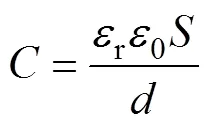
式中为电容量,F;0为真空介电常数08.854×10-15F/mm;r为相对介电常数;为2个平行板间相对覆盖面积,mm2;为2个平行板间的距离,mm。
小麦种子与空气的相对介电常数不同,当小麦种子通过平行板电容传感器时,电容传感器的介电常数会发生改变,导致输出电容量发生变化。当小麦种子通过平行板电容传感器时,电容传感器的介电常数[21]为
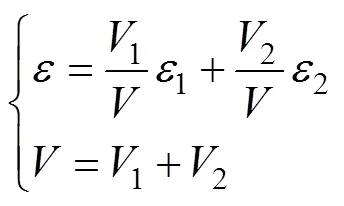
式中1为小麦种子的相对介电常数;2为空气的相对介电常数,2≈1.000585;1为小麦种子所占体积,mm3;2为空气所占体积,mm3;为电容传感器2个平行极板间的总体积,mm3。
当传感器内有小麦种子通过时,由式(1)和(2)可知,小麦种子引起的电容变化量Δ可表示为

式中1为有小麦种子通过时传感器的电容量,F;2为没有小麦种子通过时传感器的电容量,F。
由式(3)可知,当温度及湿度不变时,电容的变化量与小麦种子所占的体积成正比,对于大小相近的小麦种子,可以通过检测电容的变化量来检测小麦种子的数目。
2 精量播种检测系统设计
2.1 精量播种传感器结构
如图1所示,精量播种传感器由排种管接口、V型挡板、2片电容电极、信号检测及处理电路和电路安装盒等组成。
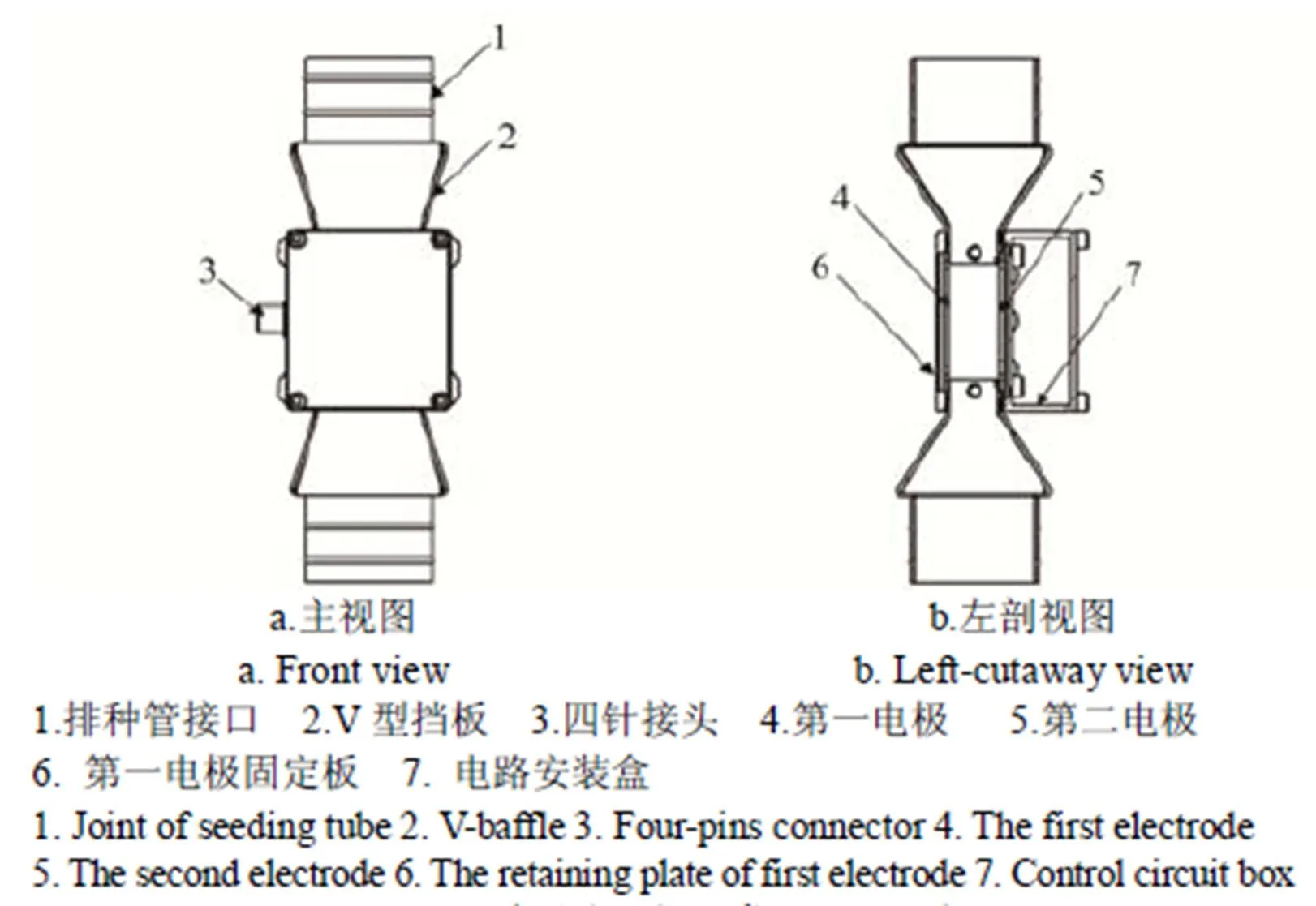
图1 精量播种传感器结构简图
2.2 电容平行极板设计
相对介电常数随温度升高而增大[28],为降低温度对传感器的影响,传感器的极板材料应选用温度系数较低的金属材料。为了减少边缘效应的影响,电容的极板要做得很薄。为保证传感器在振动和温差较大的工作环境中具有高的稳定性,本文采用部分区域覆铜技术,在1 mm厚的PVC板上制作电容传感器的平行极板,覆铜区域的铜箔厚度为0.035 mm。
根据中国科学院电子学研究所对小麦相对介电常数的测量,小麦种子相对介电常数为2.5~3.0[29]。本文选取小麦种子相对介电常数中间值2.75,以便于后面进行计算,确定电容传感器的尺寸参数。通过大量实际测量得出小麦籽粒长约6.5 mm,直径为3.4~3.8 mm,则单粒小麦种子的体积(小麦种子近似圆柱体)近似为
1≈ π·1.72·6.5 (4)
带入式(3)有:

电容检测芯片选用AD7746(电容模数转换芯片),精度为0.004 pF,若要辨别出1粒小麦种子,则根据式(5)Δ需要满足条件Δ>0.004,即

根据式(6),2个平行极板间距离设计为=15 mm。
电容极板的尺寸与传感器和排种轮的安装位置有关。如图2所示,忽略外部振动和摩擦等因素的影响,可以认为种子在排种器的同一高度沿着排种器排种轮的切线方向以一定速度排出并在重力作用下运动[22]。

注:H为排种口至平行极板上边界的距离,mm;V为种子的初始速度,mm/s;θ为排种角,即小麦种子初始速度V方向与水平方向之间的夹角,rad;b为平行极板的长度,mm;d为两平行极板间的距离,mm。
为了保证检测精度,应尽可能使小麦种子在通过电容传感器平行极板时被采样1次,种子通过平行极板时被采样1次的约束条件为:
t< Δ< 2 t(7)
式中t为采样周期,即2次采样之间的时间间隔,s;Δ为小麦种子通过平行极板的时间,s。
种子通过平行极板的时间Δ由种子到平行极板上边界的速度1和平行极板的长度决定,满足公式
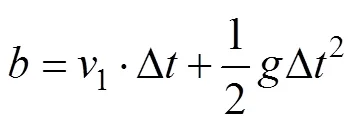
解得

种子到达平行极板上边界的速度1由小麦种子的初始速度、排种口至平行极板上边界的距离和排种角决定。
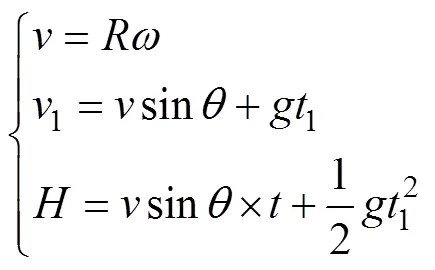
式中为排种轮半径,mm;为排种轮的角速度,rad/s;1为种子到平行极板上边界的时间,s;为重力加速度,9.8×103mm/s2。
根据式(8)、(9)和(10)求得种子通过平行极板的时间为

常用小麦排种器排种轮实测参数为=27 mm,= 1.047 2 rad;=147 mm,根据式(11)、、电容模数转换时间等综合考虑,确定平行极板的长度=30 mm,宽度=30 mm。当排种轮转速为20 r/min时,由式(11)求得Δ16.85 ms,根据式(7)初步设定采样周期为15 ms。
2.3 检测电路设计
小麦种子通过电容传感器引起的电容变化量较小,检测精度会受到寄生电容和环境的影响,为实现高精度的测量,选用模数转换芯片AD7746,可以有效地降低这些因素带来的影响。小麦排种精密检测信号采集与处理电路原理如图3所示。该电路由STM8单片机、电容模数转换芯片AD7746等组成。STM8单片机主要任务是对电容模数转换芯片AD7746进行初始化配置,设置转化速率为66.7 Hz(采样周期为15 ms),采集电容的变化值,将采集的数据进行预处理和存储,并将数据传送给上位机。
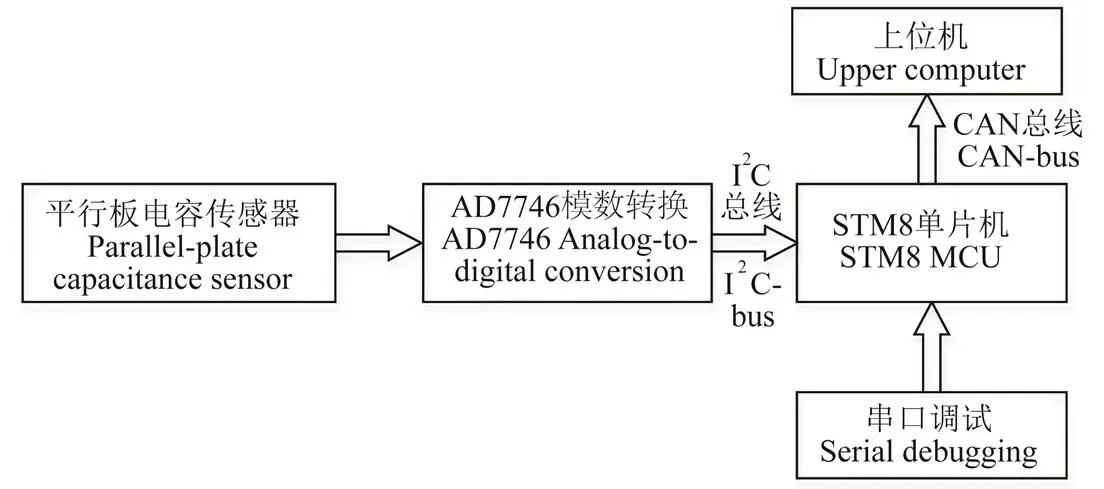
图3 检测电路原理图
振动、电磁干扰等因素对电容传感器的影响较大。信号采集与处理电路和平行极板之间采用导线连接,为了避免导线振动而产生随机噪声电容,则需要尽可能缩短连接导线的长度并通过固体胶将连接导线与电路安装盒固定。为了降低电磁干扰对检测结果的影响,传感器电路安装盒为铁质材料制成的密闭空间,信号采集与处理电路和连接导线全部安装于铁质金属盒中,电容传感器的电路通过航空接头与外界进行数据传输。
3 小麦播种量检测试验
3.1 试验平台
试验平台由步进电机及驱动器、种箱、排种轮、电容传感器、接种盒和上位机等组成,其结构如图4a所示。57BYG250B步进电机控制排种轮的转速,进而控制小麦种子的流量。电容传感器用于电容值的采集,并将数据通过CAN总线传送给上位机进行处理。试验流程如图4b所示。
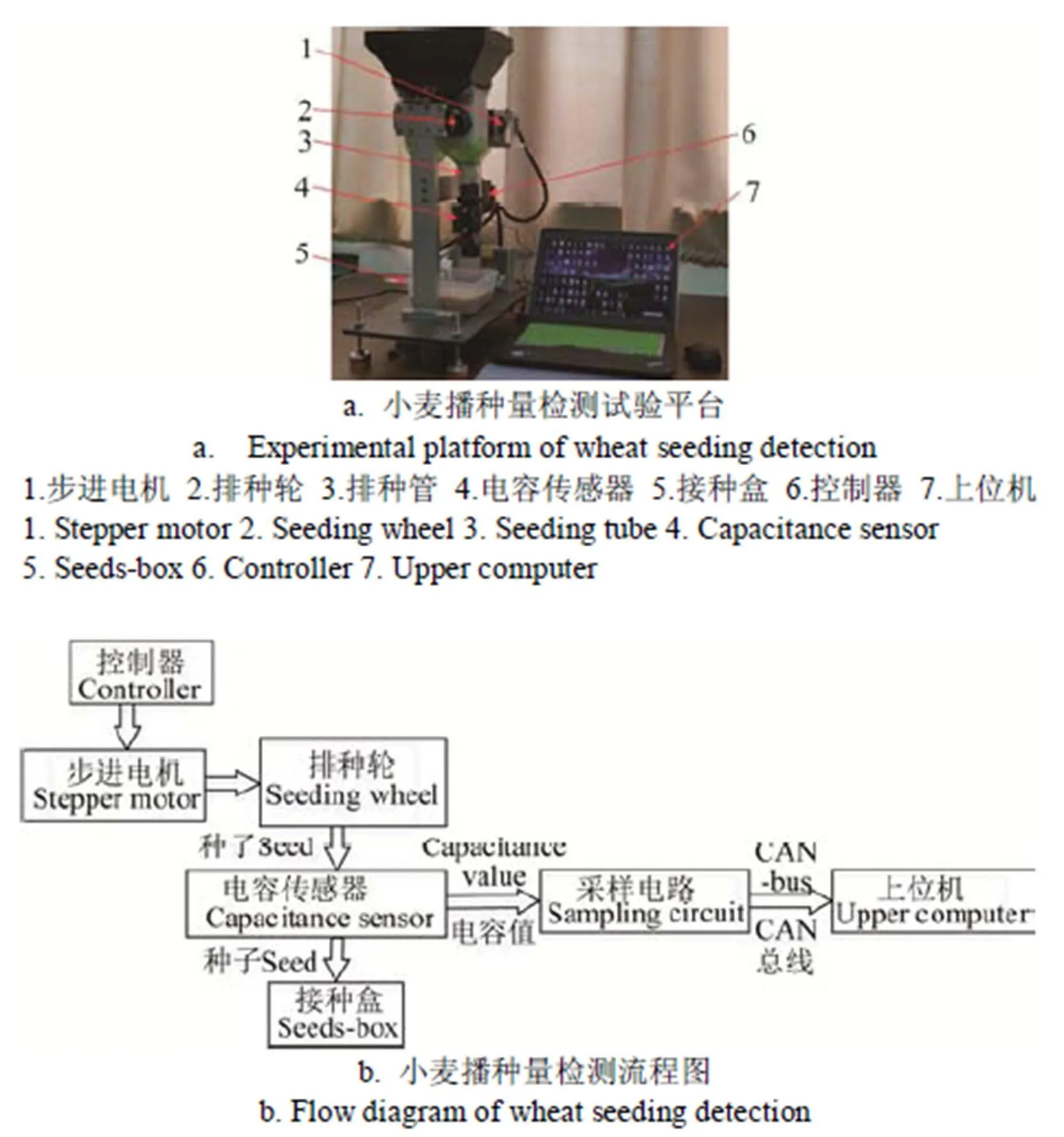
图4 小麦播种量检测试验平台及播种量检测流程图
3.2 小麦种子数量与电容变化量线性关系试验
3.2.1 确定基础电容值
选用变地金生产的小麦种子进行试验,首先人工去除一些不饱满的颗粒,选取大小相近的小麦种子进行试验。每组试验前先启动采样程序采样1 500个数据(没有小麦种子流过时的电容值),对这1 500个数据求均值,作为检测系统的基础电容值C。
3.2.2 线性关系试验
设置系统的采样周期为15 ms,分别以1、2、3、4、5和6粒种子同时下落进行6组试验,每组试验进行100次。在每组试验中,对得到的100个电容变化量求均值,以均值作为对应小麦数量引起的电容变化量。
对电容变化量与2个平行极板间小麦种子数量进行最小二乘拟合,得到两者之间的关系为:

电容变化量与2个平行极板间小麦种子数量最小二乘拟合直线如图5所示,进一步计算得到线性相关系数为0.996 6,这表明电容变化量与2个平行极板间小麦数量之间存在很高的线性相关性,在电容传感器内部,每粒小麦种子引起的电容变化量约为0.003 7 pF。
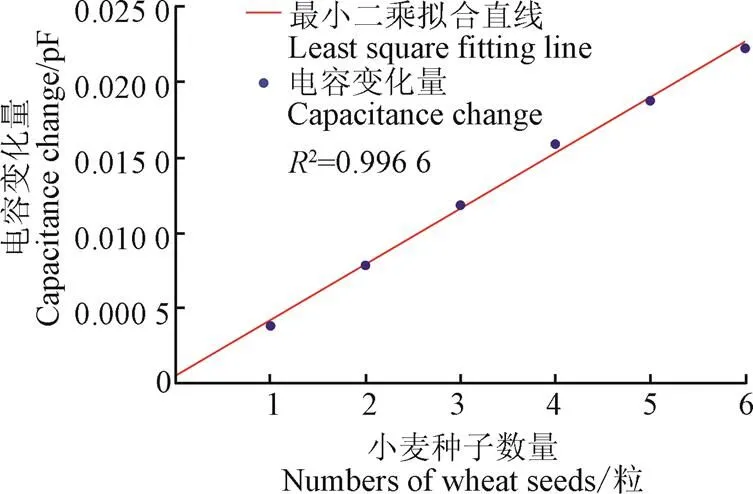
图5 电容变化量与种子数量最小二乘拟合直线
3.3 小麦播种量实时检测试验
3.3.1 小麦播种量检测最小二乘回归模型
当小麦种子通过电容传感器时,会形成脉冲信号,对于单个采样点而言,由种子数量与电容变化量线性关系试验可知电容变化量与小麦数量成正比。启动电机带动排种轮转动后,在检测小麦播种量的过程中,系统的检测结果会伴有微小波动,波动范围在0.001 5 pF以内,为此设定判断阈值,只有满足阈值条件的脉冲峰值才被认为是有效的,即需满足下式:

式中C为第采样点的电容值,pF;C为传感器的基础电容;为判断阈值。
正常单粒小麦种子经过电容传感器引起的电容变化值约为0.003 7 pF,通过多次重复预试验确定阈值0.002 8,以排除电容自身微小波动引起的误判。
在每组采样试验中,采样周期设置为15 ms,采样点数设置为1 500个,排种轮转速(步进电机输出转速)设置为20 r/min,为准确获取小麦种子通过电容传感器时引起的电容变化量,在启动采样命令后再控制步进电机带动排种轮转动,在系统采样完成前关闭步进电机。小麦种子通过电容传感器时,电容值会明显增大,根据这个特征提取小麦通过电容传感器时对应的电容值数据,一共进行40组试验(以下试验数据采样均采用此方法)。将满足式(13)条件的所有采样点处的电容值进行积分,同时人工统计出经过电容传感器的小麦种子粒数如表1所示。
将满足式(13)条件的所有采样点处的电容值进行积分

将表1中实际经过电容传感器的小麦籽粒数与电容积分值进行最小二乘拟合,得到两者之间的关系为:

式中为根据公式(14)计算得到的电容积分值,pF。
小麦籽粒数与电容积分值最小二乘拟合直线如图6所示,计算得到线性相关系数为0.993 6,这表明实际经过电容传感器的小麦种子粒数与电容积分值之间存在很高的线性相关性。
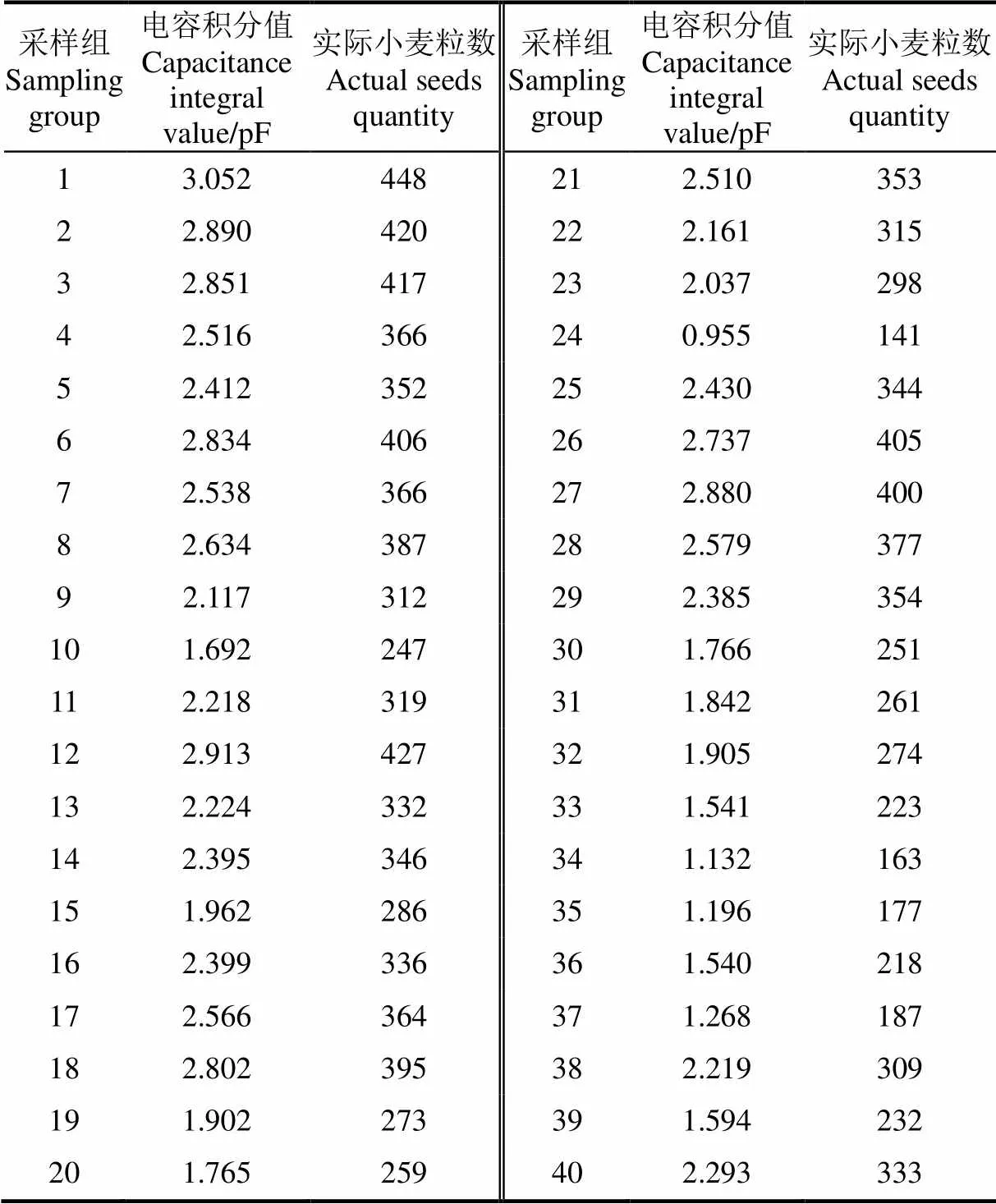
表1 每组采样中电容积分值和实际小麦粒数
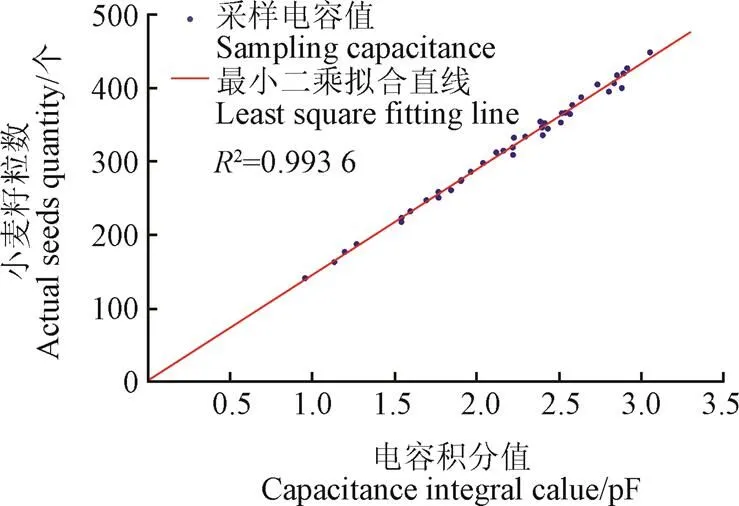
图6 小麦籽粒数与电容积分值最小二乘拟合直线
3.3.2 不同排种轮转速下播种量实时检测试验
为进一步检验该系统的可靠性和检测精度,分别在20、25和35 r/min三种排种轮转速下进行试验。设置系统采样周期为15 ms,每种转速下进行6组试验。在每组试验的采样数据中,将满足式(13)的所有采样点处的电容值进行积分,再根据式(15)计算出小麦籽粒数,由计算出的籽粒数与人工统计的实际籽粒数相对比,计算相对误差,其结果如表2所示。
由表2可以发现:采样周期保持15 ms情况下,在排种轮转速为20 r/min时,利用拟合关系式(15)计算得到的小麦籽粒数与实际籽粒数两者之间的相对误差较小,介于-1.57%~1.37%之间。然而,在排种轮转速为25和35 r/min时,利用拟合关系式(15)计算得到的小麦籽粒数与实际籽粒数两者之间的相对误差较大,而且随着转速的提高,相对误差逐渐增大,其偏离程度如图7所示。

表2 不同排种轮转速下播种量实时检测结果(采样周期15 ms)
3.3.3 改变采样周期下播种量实时检测试验
在理想情况下,小麦种子通过平行极板时被电容传感器采样一次。试验表明在同一转速下,实际经过电容传感器的小麦籽粒数与电容积分值之间存在很高的线性相关性,这是因为种子通过平行极板时被采样的次数符合同一分布。然而,对于不同的转速,根据(11)式可知种子通过平行极板的时间Δ会发生变化,这会影响种子通过平行极板时被采样次数的分布情况。这就是在同一采样周期下,排种轮转速逐渐提高时,利用拟合关系式(15)计算得到的小麦籽粒数与实际籽粒数之间相对误差逐渐增大的原因。
为使得该系统满足较大的排种轮转速范围播种量检测,本文通过试验发现,当排种轮转速每增加5 r/min时,采样周期相应减少0.4 ms,则拟合关系式(15)仍可以使用。为检验不同转速条件下,通过改变采样周期,使用拟合关系式(15)的精度,分别在排种轮转速25、30、35、40、45、50、55和60 r/min下进行试验。对应的采样周期从14.6 ms开始依次减少0.4 ms,每种转速下进行5组试验。在每组试验的采样数据中,将满足式(13)条件的所有采样点处的电容值进行积分,再根据式(15)计算出小麦籽粒数,由计算出的小麦籽粒数与实际籽粒数相比较,计算相对误差,其结果如表3所示。由表3可知:在排种轮转速25、30、35 r/min等8种下,改变对应的采样周期,根据式(15)计算出该系统的相对误差介于-2.26%~2.17%之间。这表明通过改变对应的采样周期,该系统对不同排种轮转速均具有较高的检测精度。
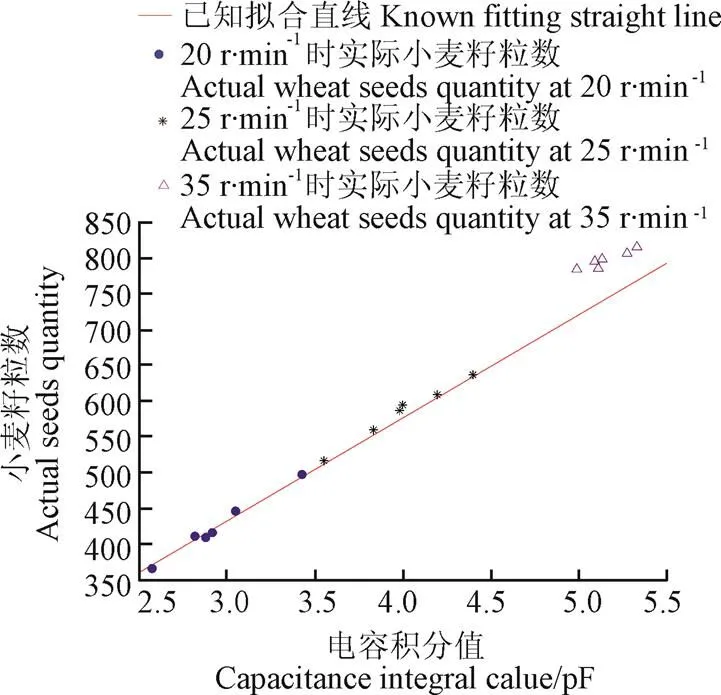
图7 采样周期为15 ms时不同排种轮转速下小麦籽粒数
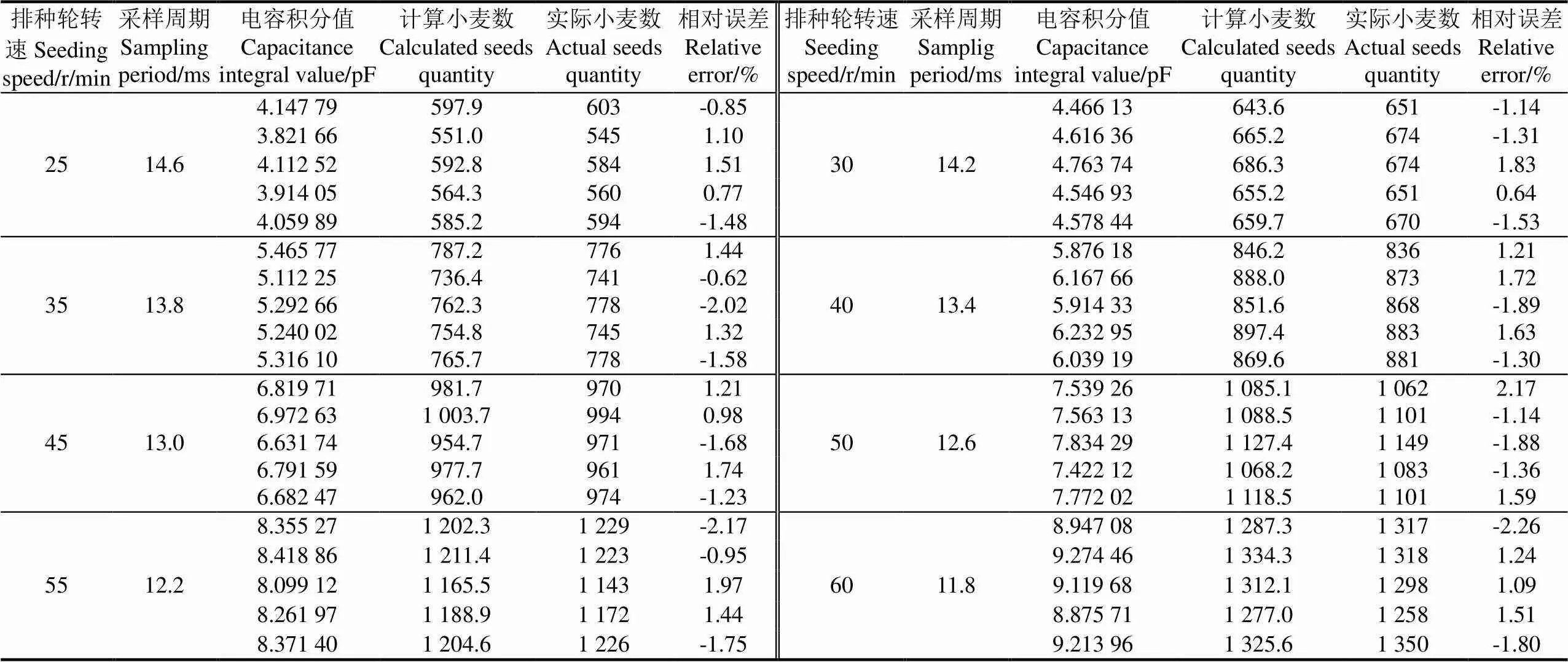
表3 不同排种轮转速和采样周期下播种量实时检测结果
4 结 论
1)基于电容法设计了小麦精量播种机播种量实时检测系统。由检测分辨率和排种速度与采样频率约束关系确定了传感器结构尺寸,确定了实现精量检测的结构基础。
2)建立了采样周期15 ms、排种轮转数(步进电机输出转速)20 r/min时的小麦籽粒数与电容积分值之间的最小二乘回归模型,试验表明:排种轮转数为20 r/min时,使用该模型计算得到的小麦籽粒数与实际籽粒数两者之间的相对误差介于-1.57%~1.37%之间,然而,在排种轮转数为25和35 r/min时,使用该模型计算得到的小麦籽粒数与实际籽粒数两者之间的相对误差较大,而且随着转速的提高,相对误差逐渐增大。
3)为了使得该模型适用于不同的排种轮转数,提出了一种通过改变采样周期的方法,以使拟合关系式(15)适用于不同的排种轮转速,试验表明当排种轮转数每增加5 r/min时,将采样周期相应减少0.4 ms,则拟合关系式(15)仍可以使用,使用该拟合关系式计算得到的小麦籽粒数与实际籽粒数两者之间的相对误差介于-2.26%~2.17%之间。由此可见,对不同的排种轮转速,本文所设计的检测系统均具有较高的检测精度,这为实现小麦播种量的精准检测提供了一种有效途径。
[1] 杨丽,颜丙新,张东兴,等. 玉米精密播种技术研究进展[J].农业机械学报,2016,47(11):38-48. Yang Li, Yan Bingxin, Zhang Dongxing, et al. Research progress on precision planting technology of maize[J]. Transactions of The Chinese Society of Agricultural Machinery, 2016, 47(11): 38-48. (in Chinese with English abstract)
[2] 苑严伟,张小超,吴才聪,等. 玉米免耕播种施肥机精准作业监控系统[J].农业工程学报,2011,27(8):222-226. Yuan Yanwei, Zhang Xiaochao, Wu Caicong, et al. Precision control system of no-tillage corn planter[J]. Transactions of the Chinese Society of Agricultural Engineering (Transactions of the CSAE), 2011, 27(8): 222-226. (in Chinese with English abstract)
[3] 李雷霞,郝志明,杨薇,等. 精密播种机排种性能检测系统的研制[J].农业工程学报,2012,02(8):16-19.Li Leixia, Hao Zhiming, Yang Wei, et al. Design of seeding performance detection system for precision seeder[J]. Transactions of the Chinese Society of Agricultural Engineering (Transactions of the CSAE),2012, 02(8): 16-19. (in Chinese with English abstract)
[4] 张继成,陈海涛,欧阳斌林,等. 基于光敏传感器的精密播种机监测装置[J].清华大学学报(自然科学版),2013(2):265-268.
Zhang Jicheng, Chen Haitao, Ouyang Binlin, et al. Monitoring system for precision seeders based on a photosensitive sensor[J]. Tsinghua Science and Technology (Science and Technology),2013(2): 265-268 (in Chinese with English abstract)
[5] 朱瑞祥,葛世强,翟长远,等. 大籽粒作物漏播自补种装置设计与试验[J].农业工程学报,2014,30(21):1-8.Zhu Ruixiang, Ge Shiqiang, Zhai Changyuan, et al. Design and experiment of automatic reseeding device for miss-seeding of crops with large grain [J]. Transactions of the Chinese Society of Agricultural Engineering (Transactions of the CSAE),2014, 30(21): 1-8. (in Chinese with English abstract)
[6] 郝向泽,何旭鹏,邹翌,等. 基于光电传感器的精密播种机排种性能监测系统的研究[J]. 华南农业大学学报,2017,38(1):120-124.
Hao Xiangze, He Xupeng, Zou Yi, et al. Research on the sowing performance monitoring system for precision seeders based on photoelectric sensor[J]. Journal of South China Agricultural University, 2017, 38(1): 120-124.(in Chinese with English abstract)
[7] 车宇,伟利国,刘婞韬,等. 免耕播种机播种质量红外监测系统设计与试验[J].农业工程学报,2017,33(Supp.1):11-16.Che Yu, Wei Liguo, Liu Xingtao, et al. Design and experiment of seeding quality infrared monitoring system for no-tillage seeder[J]. Transactions of the Chinese Society of Agricultural Engineering (Transactions of the CSAE),2017, 33(Supp.1): 11-16. (in Chinese with English abstract)
[8] 宋鹏,张俊雄,李伟,等. 精密播种机工作性能实时监测系统[J]. 农业机械学报,2011,42(2):71-74.
Song Peng, Zhang Junxiong, Li Wei, et al. Real time monitoring system for accuracy of precision seeder [J]. Transactions of the Chinese Society for Agricultural Machinery, 2011, 42(2): 71-74. (in Chinese with English abstract)
[9] 郑一平,花有清,陈丽能,等. 水稻直播机播种监测器研究[J]. 农业工程学报,2005,21(4):77-80.
Zheng Yiping, Hua Youqing, Chen lineng, et al. Seeding detectors for rice drill [J]. Transactions of the Chinese Society for Agricultural Engineering (Transactions of the CSAE), 2005, 21(4): 77-80. (in Chinese with English abstract)
[10] Okopnik D L, Falate R. Usage of the DFRobot RB-DFR-49 infrared sensor to detect maize seed passage on a conveyor belt[M]. Elsevier Science Publishers B. V. 2014.
[11] Al-Mallahi A A, Kataoka T. Application of fibre sensor in grain drill to estimate seed flow under field operational conditions[M]. Elsevier Science Publishers B. V. 2016.
[12] Al-Mallahi A. Monitoring the flow of seeds in grain drill using fiber sensor[C] //Agricontrol, 2013: 311-314.
[13] Hoberge S M Z, Hilleringmann U, Jochheim C, et al. Piezoelectric sensor array with evaluation electronic for counting grains in seed drills[C] // Africon. IEEE, 2011: 1-6.
[14] 马旭,王剑平,胡少兴,等. 用图像处理技术检测精密排种器性能[J].农业机械学报,2001,32(4):34-37.Ma Xu, Wang Jianping, Hu Shaoxing, et al. Detection of a precision seedmeter performance using image processing technology[J]. Transactions of The Chinese Society of Agricultural Machinery, 2001, 32(4): 34-37. (in Chinese with English abstract)
[15] 廖庆喜,邓在京,黄海东. 高速摄影在精密排种器性能检测中的应用[J]. 华中农业大学学报,2004,23(5):570-573.
Liao Qingxi, Deng Zaijing, Huang Haidong. Application of the high speed photography checking the precision metering performances[J]. Journal of Huazhong Agricultural University, 2004, 23(5): 570-573. (in Chinese with English abstract)
[16] 张海娜,马玉芳. 基于图像处理的机器播种参数检测方法研究[J]. 测控技术,2015,34(2):44-47.
Zhang Haina, Ma Yufang. Research on performance testing method of machine sowing based on image processing [J]. Measurement & Control Technology, 2015, 34(2): 44-47. (in Chinese with English abstract)
[17] 周茉,张学明,刘志刚. 基于高速摄像系统和图像边缘检测的精密排种器设计[J]. 农机化研究,2016(9):108-112.
Zhou Mo, Zhang Xueming, Liu Zhigang. Designn metering devic for precisioe based on high—speed camera and image edge detection[J]. Journal of Agricultural Mechanization Research, 2016(9): 108-112. (in Chinese with English abstract)
[18] 陈进,边疆,李耀明,等. 基于高速摄像系统的精密排种器性能检测试验[J].农业工程学报,2009,25(9):90-95.Chen Jin, Bian Jiang, Li Yaoming, et al. Performance detection experiment of precision seed metering device based on high-speed camera system[J]. Transactions of the Chinese Society of Agricultural Engineering (Transactions of the CSAE),2009, 25(9): 90-95. (in Chinese with English abstract)
[19] Zhao X, Xu L, Wang Y, et al. Directional adsorption characteristics of corn seed based on fluent and high-speed photography[J]. Transactions of the Chinese Society for Agricultural Machinery, 2014, 45(10): 103-109, 28.
[20] Karayel D, Wiesehoff M. Laboratory measurement of seed drill seed spacing and velocity of fall of seeds using high-speed camera system[J]. Computers & Electronics in Agriculture, 2006, 50(2): 89-96.
[21] 周利明,张小超,苑严伟. 小麦播种机电容式排种量传感器设计[J].农业工程学报,2010,26(10):99-103.Zhou Liming, Zhang Xiaochao, Yuan Yanwei. Design of capacitance seed rate sensor of wheat planter [J]. Transactions of the Chinese Society of Agricultural Engineering (Transactions of the CSAE),2010, 26(10): 99-103. (in Chinese with English abstract)
[22] 周利明,王书茂,张小超,等. 基于电容信号的玉米播种机排种性能监测系统[J].农业工程学报,2012,28(13):16-21.Zhou Liming, Wang Shumao, Zhang Xiaochao, et al. Seed monitoring system forcorn planter basedon capacitance signal [J]. Transactions of the Chinese Society of Agricultural Engineering (Transactions of the CSAE),2012, 28(13): 16-21. (in Chinese with English abstract)
[23] 孙伟,王关平,吴建民. 勺链式马铃薯排种器漏播检测与补种系统的设计与试验[J].农业工程学报,2016,32(11):8-15.Sun Wei, Wang Guanping, Wu Jianmin. Design and experiment on loss sowing testing and compensation system of spoon-chain potato metering device[J]. Transactions of the Chinese Society of Agricultural Engineering (Transactions of the CSAE),2016, 32(11): 8-15. (in Chinese with English abstract)
[24] Kandala C V, Sundaram J. Nondestructive measurement of moisture content using a parallel-plate capacitance sensor for grain and nuts[J]. IEEE Sensors Journal, 2010, 10(7): 1282-1287.
[25] 周利明,李树君,张小超,等. 基于电容法的棉管籽棉质量流量检测[J].农业机械学报,2014,45(6):47-52.Zhou Liming, Li Shujun, Zhang Xiaochao, et al. Detection of seedcotton mass flow based on capacitance approach[J]. Transactions of The Chinese Society of Agricultural Machinery, 2014, 45(6): 47-52. (in Chinese with English abstract)
[26] 郭文川,刘驰,杨军. 小麦秸秆含水率测量仪的设计与试验[J]. 农业工程学报,2013,29 (1):33-40.
Guo Wenchuan, Liu Chi, Yang Jun. Design and experiment on wheat straw moisture content meter[J]. Transactions of the Chinese Society for Agricultural Engineering, (Transactions of the CSAE) 2013, 29 (1): 33-40. (in Chinese with English abstract)
[27] 田雷,衣淑娟,尧李慧,等. 基于电容信号的排种监测系统研究[J].农机化研究,2018,40(1):189-194.Tian Lei, Yi Shuhuan, Yao Lihui, et al. Kind of monitoring system basedon capacitance signal research[J]. Jornual of Agricultural Mechanization Research, 2018, 40(1): 189-194. (in Chinese with English abstract)
[28] 周利明. 基于电容法的棉花产量和播种量检测技术研究[D]. 北京:中国农业大学,2014.
Zhou Liming. Research on Detection of Yied and Seeding Rate of Cotton Based on Capacitive Method[D]. Beijing: China Agricultural University, 2014.
[29] 秦瑶,陈洁,方广有,等. 微波透射法对小麦介电特性的测量[J].农机化研究,2010,32(7):156-159. Qin Yao, Chen Jie, Fang Guangyou, et al. Microwave transmission method to detecting permittivity of wheat[J]. Jornual of Agricultural Mechanization Research, 2010, 32(7): 156-159. (in Chinese with English abstract)
Design and test of capacitive detection system for wheat seeding quantity
Chen Jianguo, Li Yanming※, Qin Chengjin, Liu Chengliang
(200240)
At present, the methods of seeding detection are photoelectric-based method, image-based method and capacitance-based method. For the photoelectric-based method, the detection accuracy of photoelectric sensor is affected by the vibration, light, temperature and other factors on the farmland. When multiple seeds fall simultaneously, the refraction phenomenon of photoelectric sensor also affects the accurate detection. For the image-based method, its high precision detection provides a new way to improve the performance of wheat-planter seeding. However, image processing technology requires special equipment with high cost, and cameras are easy to be interfered by external light. Consequently, it is difficult to be widely applied in the complex environment on the farmland. Compared with photoelectric-based and image-based methods, the capacitance-based method is less affected by light and dust and thus has a strong environmental adaptability. However, when multiple seeds fall simultaneously, the detection accuracy of the capacitance-based method still needs to be improved. In this paper, a precise detection system for wheat-planter seeding quantity was designed using the capacitance-based method. The detection resolution and the constraint relation between the seeding speed and the sampling frequency determine the structure size of the capacitance sensor. To guarantee the detection accuracy, every seed should be detected only once as far as possible when it passes through the parallel plate of capacitance sensor. Then the initial sampling period can be determined according to the above sampling method. Meanwhile, high detection accuracy is difficult to be achieved due to the small capacitance change in detection system and the influence of parasitic capacitance and environment in conditioning circuit. Therefore, the capacitance analog-to-digital conversion chip of AD7746 is utilized to effectively reduce the error caused by the above factors. The signal acquisition and processing circuit for precise detection of wheat-planter was designed based on the AD7746 and the single chip microprocessor of STM8. Ideally, the seed passing through the capacitor plate will be sampled only once by the capacitive sensor. However, the times of the seed passing through the parallel plate will be changed with different wheat-planter seeding speeds, which will affect the distribution of sampling times when the seed passes through the capacitor plate. The least squares regression model of the real-time wheat-planter seeding quantity detection was built under the condition with the sampling period of 15 ms and the wheat-planter speed of 20 r/min. The results showed that when the sampling period is 15 ms, the relative error between the number of seeds calculated by the least squares regression model and the actual number of seeds increases with the speed of the wheat planter. Consequently, to make the detection system suitable for the different seeding speeds, a detecting method was proposed by changing the sampling period, in which the sampling period was reduced by 0.4 ms when the wheat-planter speed was increased by 5 r/min. The least square regression model established above is still applicable for this case. The results showed that high detection accuracy can be obtained for different seeding speeds, and the relative error was between -2.26%-2.17%.
agricultural machinery; sensors; design; seeding quantity; capacitance method; least squares regression model
10.11975/j.issn.1002-6819.2018.18.007
S127
A
1002-6819(2018)-18-0051-08
2018-05-15
2018-06-21
国家重点研发计划项目(2016YFD070030503);国家重点研发计划项目(2016YFD0700505)
陈建国,男,博士生,主要从事高精度农机方面研究。 Email:jianguo890811@163.com
李彦明,男,副教授,主要从事机电系统辨识及自适应高精度控制方面研究。Email:ymli@sjtu.edu.cn
陈建国,李彦明,覃程锦,刘成良. 小麦播种量电容法检测系统设计与试验[J]. 农业工程学报,2018,34(18):51-58. doi:10.11975/j.issn.1002-6819.2018.18.007 http://www.tcsae.org
Chen Jianguo, Li Yanming, Qin Chengjin, Liu Chengliang. Design and test of capacitive detection system for wheat seeding quantity[J]. Transactions of the Chinese Society of Agricultural Engineering (Transactions of the CSAE), 2018, 34(18): 51-58. (in Chinese with English abstract) doi:10.11975/j.issn.1002-6819.2018.18.007 http://www.tcsae.org

